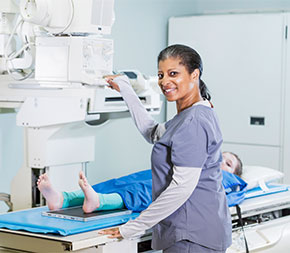In this Article

Have you ever broken a bone? If you have, you’ve likely come into contact with a radiology technologist. RTs do much more than take images of fractured wrists and ankles, though.
Radiology technologists create images that help doctors diagnose and treat illness and other health problems. They may work in a hospital, outpatient imaging center, physician’s office, or other clinic.
What Does a Radiology Technologist Do?
“Radiologic technologists are part of a healthcare team. They provide skills, knowledge, and expertise in imaging and procedures,” says Peter Rath, MPA, R.T. (R), ARRT, a radiology technician on staff at the American Society of Radiologic Technologists, where he evaluates continuing education programs. “They might be involved in surgeries, the emergency department, a cardiac catheterization lab, or a standalone orthopedic practice. Depending on where you work, this profession can provide a lot of variety.”
If you’re dedicated to caring for others, comfortable with technology, and meet the physical requirements to be a radiology technologist, this might be the healthcare career for you.
To start, radiology technologists also are known as X-ray technicians, radiologic technologists, and radiographers. In addition to X-rays, RTs can earn certifications in other imaging procedures, such as MRI, CT scans, sonography, and mammography.
A common misconception is that their job is limited to taking X-ray images when patients suspect they have a broken bone or another internal injury. In reality, the responsibilities of a radiology technologist are much more varied.
X-ray imaging can also help diagnose illnesses, spot tumors, identify blockages, and much more. A radiology technologist may also work with a medical team to provide ongoing imaging, such as during heart surgery.
The images radiology technologists take depend on what information a doctor is seeking, and they may need to take multiple images at different angles.
“Radiologic technologists must be comfortable interacting with sick, ill, and injured patients, and they need to be able to work with a team of healthcare providers,” Rath says. “You’ll need both people skills and physical skills.”
Radiology Technologist Versus Sonographer
Both radiology technologists and ultrasound technicians use technology to “see” inside a patient for diagnoses and treatments. The professions overlap but there are distinct differences, including:
Roles and Responsibilities
“Radiologic technologists can work elbow-to-elbow with healthcare team members to provide a critical service,” Rath says.
In general, RTs create images using non-invasive technologies so other providers can better understand what’s happening inside a patient’s body. X-rays in particular are painless for patients and a very low risk when used properly.
Radiology technologists must know how to:
“Much of what a radiologic technologist does depends on the setting where they work,” Rath says.
Workplaces
“When it comes to a career, radiology technologists can take multiple pathways to do different things in different settings,” Rath says. Depending on your interests, passions, and career ambitions, you can search for jobs in the following settings.
- Hospitals:
- “Radiographers in hospitals do much more than take X-rays of a walk-in patient; they also deal with emergency situations, run portable X-ray equipment to do bedside exams, or provide imaging in the operating room,” Rath says. “Variety is the spice of life in hospital careers!”
- Physicians’ Offices:
- A radiology technologist wouldn’t work in a solo practice doctor’s office but may work in an office with multiple physicians.
- Outpatient Care Centers:
- A medical facility that focuses on a specialty (such as orthopedics) may provide imaging for outpatient needs.
- Medical and Diagnostic Labs:
- “Technologists in medical imaging centers or labs provide scheduled imaging, so not acutely needed exams,” Rath says. “There is a high volume of patients, so radiographers perform imaging on many people in a day.”
- Imaging Equipment Vendors:
- Companies that sell imaging equipment, such as MRI or X-ray machines, employ radiography technologists to develop products and educate customers.
A Day in the Life of a Radiographer
A typical day as a radiographer depends on where they work. It’s helpful to think of workplaces in two main categories—hospital settings and imaging centers—says Rath.
Depending on the size of the healthcare facility, radiographers may “float” between departments or specialize—for example, in the emergency department. They are also more likely to perform imaging that is urgent.
In contrast, radiology technologists in an imaging center see patients who are scheduled for non-urgent medical needs. They may take images to diagnose a herniated disc or determine how a post-operative patient is faring.
Radiographers are much more likely to “cross-train” in smaller and rural hospitals, Rath says. “These settings are more willing and have circumstances that allow a radiographer to work in mammography, MRI, and radiography. “Working in a rural or small hospital is an incredible opportunity for professional development.”
Many radiology technologists work a typical work week. Others may need to work nights or weekend shifts, especially if they work in settings that treat emergency or trauma patients.
Career Paths
“As a radiology technologist, you will probably follow a typical career ladder,” Rath says. “You’ll begin in an entry-level position and expect to work in a doctor’s office, orthopedic clinic, hospital, dedicated medical imaging center, or another setting where you’ll take X-rays.”
From that point, “there are so many ways to put together a career,” he says.
Rath suggests trying out imaging procedures aside from radiography while you’re in school or in your first years on the job. “That way you have a chance to experience different things and decide for yourself if that’s what you want to do,” he says. “You don’t have to commit to a career path wholeheartedly before knowing if it’s a good fit for you.”
Radiographers can pursue multiple career paths, including:
Radiology Technologist in Radiography
Just because you can branch out into different procedures doesn’t mean you have to. Some people are content to stick with X-rays, and you could spend an entire career doing just that. If you want to focus on one procedure, a certificate program in radiography might be a good education route. They train students in only one imaging procedure, while an associate or bachelor’s degree provides an education in all radiologic procedures.
Certifications in Multiple Imaging Procedures
Some radiographers thrive on learning a variety of imaging procedures, such as mammography, CT imaging, MRI imaging, sonography, and vascular sonography. This route requires a lot of on-the-job training and experience, plus taking specialty exams administered by the American Registry of Radiologic Technologists (ARRT).
“Pursuing certification in multiple modalities is good for people who always want to challenge themselves,” Rath says.
Supervisory or Management Roles
Radiology technologists can also work their way up within a department. Most healthcare organizations require supervisors and managers to have at least a bachelor’s degree, so if you are interested in this route, it’s smart to start out with a bachelor’s degree or earn one while working.
Specialties for Radiology Technologists
“As you get into the field, it is exciting to explore passions, interests, and career ambitions,” Rath says. “You can pursue specialties or additional modalities to do just that.”
As you look at the field, consider whether any of the following specialties strike a chord with you.
Angiography technologists use X-rays to take images of blood vessels. They help physicians identify blockages or disease, and they guide the placement of devices such as shunts.
Bone densitometry technologists use specialty X-ray equipment to measure a patient’s bone density, either in one area or the body as a whole.
Nuclear medicine technologists prepare and administer radioactive medications for treatment or diagnostics. They may use specialized cameras, PET scans, MRI, or CT scans.
Cardiovascular technologists help diagnose and treat conditions of the heart and blood vessels. They may use ultrasound technology to assist in implanting stents, pacemakers, and defibrillators.
MRI technologists operate magnetic resonance imaging machines to create diagnostic images of patients’ tissue, bones, and organs. They also may work with physicians to analyze the resulting images.
CT technologists create cross-sectional images of a patient’s organs and tissues using a computer tomography (CT) scanner. These images help other providers identify diseases or other ailments.
Mammography technologists use a mammography unit, which relies on X-rays, to create diagnostic images of the breast. They position the patient and make adjustments on a computer to create images for review.
What Makes a Successful Radiology Technologist?
“To become a radiologic technologist, you need expertise and skills in radiography,” Rath says. “To become a good radiologic technologist, you need more.”
Here are some of the top skills and traits needed in the field.
Education to Be a Radiology Technologist
To become a radiology technologist, you’ll need to complete a certificate or diploma program or earn an associate or bachelor’s degree in radiography. A certificate/diploma program typically takes a year to 14 months, while an associate degree usually takes two years. A bachelor’s takes four years and involves more advanced training. All of these programs typically require in-person clinical or lab work as well.
When you’re deciding on an educational path, you’ll need to weigh multiple factors. A certificate and associate degree generally take less time and money to complete, meaning you can earn a professional certification and start working sooner.
Licensure and Certification
There is no nationally required certification for radiology technologists, but most states require radiographers to have a credential. Rath says you would be limiting your career options if you don’t become certified because most employers require it. “Certification is the primary credential radiology technologists need to work in most hospitals and imaging centers,” he says.
In addition to certification, most states require radiology techs to be licensed. Each state has different rules and application processes, so be sure to check the requirements in the state where you work.
Radiographers start by becoming certified by the American Registry of Radiology Technologists as Radiology Technologists in Radiography (R.T.) (R).
Additional certifications are optional and require additional training.
“Being a radiologic technologist offers a multitude of professional opportunities,” Rath says. “Getting credentialed in multiple modalities is likely to help your career path.”
Salary
When you are looking into career options, the earning potential of different jobs is an important factor to consider. If you’re looking for a potentially solid income from a job that does not require education beyond a certificate, diploma, or an associate degree, radiology technology may be for you.
Job Outlook
The demand for radiology technologists will grow by 5.5% through 2032, according to the U.S. Bureau of Labor Statistics. Rath says that the aging baby boomer generation is partly behind the profession’s growth, as older people typically require more care and are living longer.
As a result, more people will need medical imaging, and that will mean higher demand for radiology techs. That said, medical imaging isn’t only for the elderly.
“As a radiologic technologist, you can work with all age groups, from neonatal all the way to geriatric,” Rath says. “Radiologic technologists are a critical person on a healthcare team for the outcome of patients.”

Written and reported by:
Catherine Ryan Gregory
Contributing Writer

With professional insight from:
Peter Rath, MPA, RT (R), ARRT
Continuing Education Program Evaluator
American Society of Radiologic Technologists